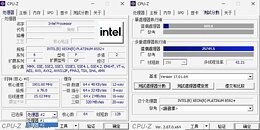- Joined
- Aug 19, 2017
- Messages
- 2,809 (1.02/day)
Intel's next-generation Emerald Rapids Xeon lineup is just around the corner, and we are now receiving more leaks as the launch nears. Today, we get to see leaks of two models: a 64-core Xeon 8592+ Platinum and a 48-core Xeon 8558U processor. First is the Xeon 8592+ Platinum, which is possibly Intel's top-end design with 64 cores and 128 threads. Running at the base frequency of 1.9 GHz, the CPU can boost up to 3.9 GHz. This SKU carries 488 MB of total cache, where 120 MB is dedicated to L2 and 320 MB is there for L3. With a TDP of 350 Watts, the CPU can even be adjusted to 420 Watts.
Next up, we have the Xeon 8558U processor, which has been spotted in Geekbench. The Xeon 8558U is a 48-core, 96-threaded CPU with a 2.0 GHz base clock whose boost frequency has yet to be shown or enabled, likely because it is an engineering sample. It carries 96 MB of L2 cache and 260 MB of L3 cache, making for a total of 356 MB of cache (which includes L1D and L1I as well). Both of these SKUs should launch with the remaining models in the Emerald Rapids family, dubbed 5th generation Xeon Scalable, on December 14 this year.





View at TechPowerUp Main Site | Source
Next up, we have the Xeon 8558U processor, which has been spotted in Geekbench. The Xeon 8558U is a 48-core, 96-threaded CPU with a 2.0 GHz base clock whose boost frequency has yet to be shown or enabled, likely because it is an engineering sample. It carries 96 MB of L2 cache and 260 MB of L3 cache, making for a total of 356 MB of cache (which includes L1D and L1I as well). Both of these SKUs should launch with the remaining models in the Emerald Rapids family, dubbed 5th generation Xeon Scalable, on December 14 this year.





View at TechPowerUp Main Site | Source




